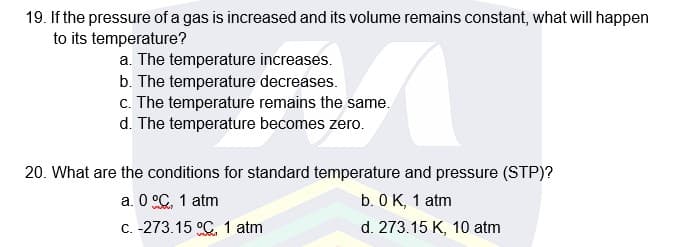If the pressure of a gas is increased and its volume remains constant, what will happen to its temperature? a. The temperature increases. b. The temperature decreases. c. The temperature remains the same. d. The temperature becomes zero.
If the pressure of a gas is increased and its volume remains constant, what will happen to its temperature? a. The temperature increases. b. The temperature decreases. c. The temperature remains the same. d. The temperature becomes zero.
Physical Chemistry
2nd Edition
ISBN:9781133958437
Author:Ball, David W. (david Warren), BAER, Tomas
Publisher:Ball, David W. (david Warren), BAER, Tomas
Chapter1: Gases And The Zeroth Law Of Thermodynamics
Section: Chapter Questions
Problem 1.21E: Pressures of gases in mixtures are referred to as partial pressures and are additive. 1.00 L of He...
Related questions
Question

Transcribed Image Text:19. If the pressure of a gas is increased and its volume remains constant, what will happen
to its temperature?
a. The temperature increases.
b. The temperature decreases.
c. The temperature remains the same.
d. The temperature becomes zero.
20. What are the conditions for standard temperature and pressure (STP)?
a. 0 °C, 1 atm
b. 0 K, 1 atm
C. -273.15 °C, 1 atm
d. 273.15 K, 10 atm

Transcribed Image Text:17. What is the volume, in liters, occupied by 1.73 moles of N2 gas at 0.992 atm pressure
and a temperature of 75° C?
а. 10.7 L
C. 49.8 L
b. 33.8 L
d. 52.2 L
18. Under which of the following volumes will 1.00 mol of an ideal gas exhibit the greatest
pressure at 300 K?
a. 0.01 L
b. 0.10 L
с. 1.00 L
d. 10.0 L
Expert Solution
This question has been solved!
Explore an expertly crafted, step-by-step solution for a thorough understanding of key concepts.
This is a popular solution!
Trending now
This is a popular solution!
Step by step
Solved in 2 steps

Recommended textbooks for you

Physical Chemistry
Chemistry
ISBN:
9781133958437
Author:
Ball, David W. (david Warren), BAER, Tomas
Publisher:
Wadsworth Cengage Learning,

Principles of Modern Chemistry
Chemistry
ISBN:
9781305079113
Author:
David W. Oxtoby, H. Pat Gillis, Laurie J. Butler
Publisher:
Cengage Learning

Chemistry & Chemical Reactivity
Chemistry
ISBN:
9781337399074
Author:
John C. Kotz, Paul M. Treichel, John Townsend, David Treichel
Publisher:
Cengage Learning

Physical Chemistry
Chemistry
ISBN:
9781133958437
Author:
Ball, David W. (david Warren), BAER, Tomas
Publisher:
Wadsworth Cengage Learning,

Principles of Modern Chemistry
Chemistry
ISBN:
9781305079113
Author:
David W. Oxtoby, H. Pat Gillis, Laurie J. Butler
Publisher:
Cengage Learning

Chemistry & Chemical Reactivity
Chemistry
ISBN:
9781337399074
Author:
John C. Kotz, Paul M. Treichel, John Townsend, David Treichel
Publisher:
Cengage Learning

Chemistry & Chemical Reactivity
Chemistry
ISBN:
9781133949640
Author:
John C. Kotz, Paul M. Treichel, John Townsend, David Treichel
Publisher:
Cengage Learning


Chemistry
Chemistry
ISBN:
9781305957404
Author:
Steven S. Zumdahl, Susan A. Zumdahl, Donald J. DeCoste
Publisher:
Cengage Learning